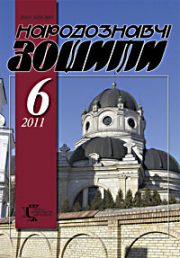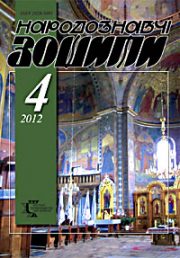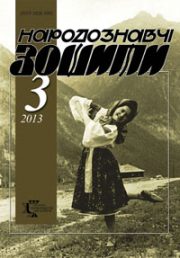The Ethnology Notebooks. 2022. № 3 (165), 536—548
UDK 75.041.7-048.76:[75.046.3: 271.4-732.3(438)]”17″
DOI https://doi.org/10.15407/nz2022.03.536
PELEKH Mariana
- ORCID ID: http://orcid.org/0000-0002-6704-0133
- Candidate of Art History, Associate Professor,
- Ukrainian Academy of Printing,
- Department of Book Graphics and Design of Printed Products,
- 17, Pidvalna street, 79000, Lviv, Ukraine,
- Contacts: e-mail: marjanna.peleh@gmail.com
Abstract. Іntroduction. The article is devoted to one of the current problems of identifying stylistic and iconographic features in the structure of iconostases and altars of churches in Galicia after the Zamoysk’Council, in the days of the greatest rise of Union Church, associated with the so-called «golden age». Until now, the preserved 18th century iconostasis ware not sufficiently studied, and this determines the relevance of the proposed article.
Problem statement. To consider the visual sources and historical preconditions that led to the appearance in the decoration of the iconostasis the new iconographic subjects, organically connected in the historical development of Europeanization of religious art culture of the region. The repertoire of the subjects of church art, introduced in the interiors of the temples of the Ukrainian Greek Catholic Church in the 18th century, is analyzed here. It became widespread by the end of the 18th century, until the period of its liquidation by the Josephine Reform and later by the Moscow Church.
Methods. Comparative-historical method, method of analysis, synthesis and empirical research methods should be noted among the general scientific methods.
Results. Based on the analysis of historical sources and preserved church works, the article identifies the style and iconography of iconostases and altars, common in the arrangement of temples of the eastern tradition of the region.
Conclusions. An analysis of the iconostasis and altars of the churches of Galicia revealed a gradual expansion of the repertoire of iconographic subjects related to Western European art culture. Along with the iconostasis typical of the Eastern rite in the 17th century, new iconostases-altars appeared in Ukraine in the form of baroque or rococo structures and reflected the leading ideas of the Catholic Church.
Keywords: iconostasis, iconography, church art of the 18th century, icons of the Mother of God, Union Church, graphic samples.
Received 3.04.2022
REFERENCES
- Konstantynowicz, J.B. (1930). Iconostases in the 17th century of the Przemysl, Lviv, Belsk and Cheіm dioceses. Characterization test (Vol. 2: Optical materials). Sanok [in Polish].
- Konstantynowicz, J.B. (1939). Ikonostases. Studies and researches (Vol. 1). Lviv [in German].
- Drahan, М. (1970). Ukrainian decorative carving of the 16th—17th centuries. Kyiv: Naukova dumka [in Ukrainian].
- Sydor, О., & Gerus, L. (Ed.). (2019). Ikonostas. In Gerus, L. Church art of Ukraine (Vol. 3, pp. 11—138). Kharkiv: Folio [in Ukrainian].
- Alexandrovych, V., & Smoliy, V. (Ed.). (2003). Architecture, fine and decorative arts, sculpture. In Smoliy, V. History of Ukrainian Culture (Vol. 3, pp. 833—925). Kyiv: Naukova dumka [in Ukrainian].
- Mudryi, S. (1999). According to the Basilian monasteries of Galicia. Galician gate, 1—2 (49—50), 2—3 [in Ukrainian].
- Krvavych, D. (1998). Ukrainian sculpture of the Rococo period. Notes of the Shevchenko Scientific Society, 236, 150—152 [in Ukrainian].
- Kossak, M. (1999). Monasteries of Galicia (reprint from 1867). Lavra, 7, 41—55; 8, 49—54; 9, 51—56; 10, 51—56 [in Ukrainian].
- Krypiakevych, I. (1926). Medieval monasteries in Galicia. Attempt catalog. Notes of the Order of St. Basil the Great, 11, 71—104 [in Ukrainian].
- Golubets, M. (2000). Materials for the catalog of Basilian monasteries in Galicia (reprint from 1930). Lavra, 2, 53—55 [in Ukrainian].
- Golubets, M. (1930). Basilian painters against the background of Western Ukrainian church painting of the XVIII century. Notes of the Order of St. Basil the Great, 3, 445—466 [in Ukrainian].
- Zholtovsky, P. (1978). Ukrainian painting of the 17th—18th centuries. Kyiv [in Ukrainian].
- Vuitsyk, V. (1998). Krasnopuschany iconostasis of Vasyl Petranovych. Notes of the Shevchenko Scientific Society, 236, 408—416 [in Ukrainian].
- Zholtovsky, P. (1983). Artistic life in Ukraine in the 16th—18th centuries. Kyiv: Naukova dumka [in Ukrainian].
- Sydor, О. (2009). Pochaiv graphics of the 18th — early 19th centuries. Apologet, 1—4 (16—19), 162—182 [in Ukrainian].
- Yarema, V. (1961). Traditions and innovations in the construction of iconostasis of the 17th— 18th centuries in the western regions of Ukraine. Orthodox Bulletin, 5—6, 177—190 [in Ukrainian].
- Vuitsyk, V. (2004). St. Onuphrius Monastery in Lviv. Bulletin of the Institute «Ukrzahidproektrestavratsiya», 14, 48—59 [in Ukrainian].
- Paranko, R., Skochylias, Ig., & Skochylias, Ir (Eds.). (2021). Zamoysk Provincial Council of the Ukrainian Union Church in 1720. Actions and resolutions. Lviv: Ukrainian Catholic University [in Ukrainian].
- Sydor, О. (1999). Saint Onuphrius the Great and ancient Ukrainian arts. Lavra, 6 8), 36—42 [in Ukrainian].
- Pelekh, M. (2011). Iconostasis of the Church of the Transfiguration of the Lord in the middle of the 17th century in the village of Zarudtsi near Lviv: iconographic description. Notes of the Shevchenko Scientific Society, 261, 115— 134 [in Ukrainian].
- Ivaseiko, S., Kozurak, M., & Melnyk, I. (2020). Ukrainian churches of Zhovkva district. Lviv [in Ukrainian].
- Katrii, Yu. (2004). Know your rite. Lviv: Svichado [in Ukrainian].
- Gronek, A., & Lozynsky, N. (Ed). (2012). Arbor Virginis in Western Ukrainian icon painting as an expression of faith in the Immaculate Conception of the Virgin Mary. In Lozynsky, N. Christian sacred tradition: faith, spirituality, art (Vol. 5, pp. 61—68). Lviv [in Polish].
- Melnyk, V. (2007). Sacred art of Galicia of the 15th—20th centuries in the exposition of the Ivano-Frankivsk Art Museum: a guide. Ivano-Frankivsk: Loleia-NV [in Ukrainian].






